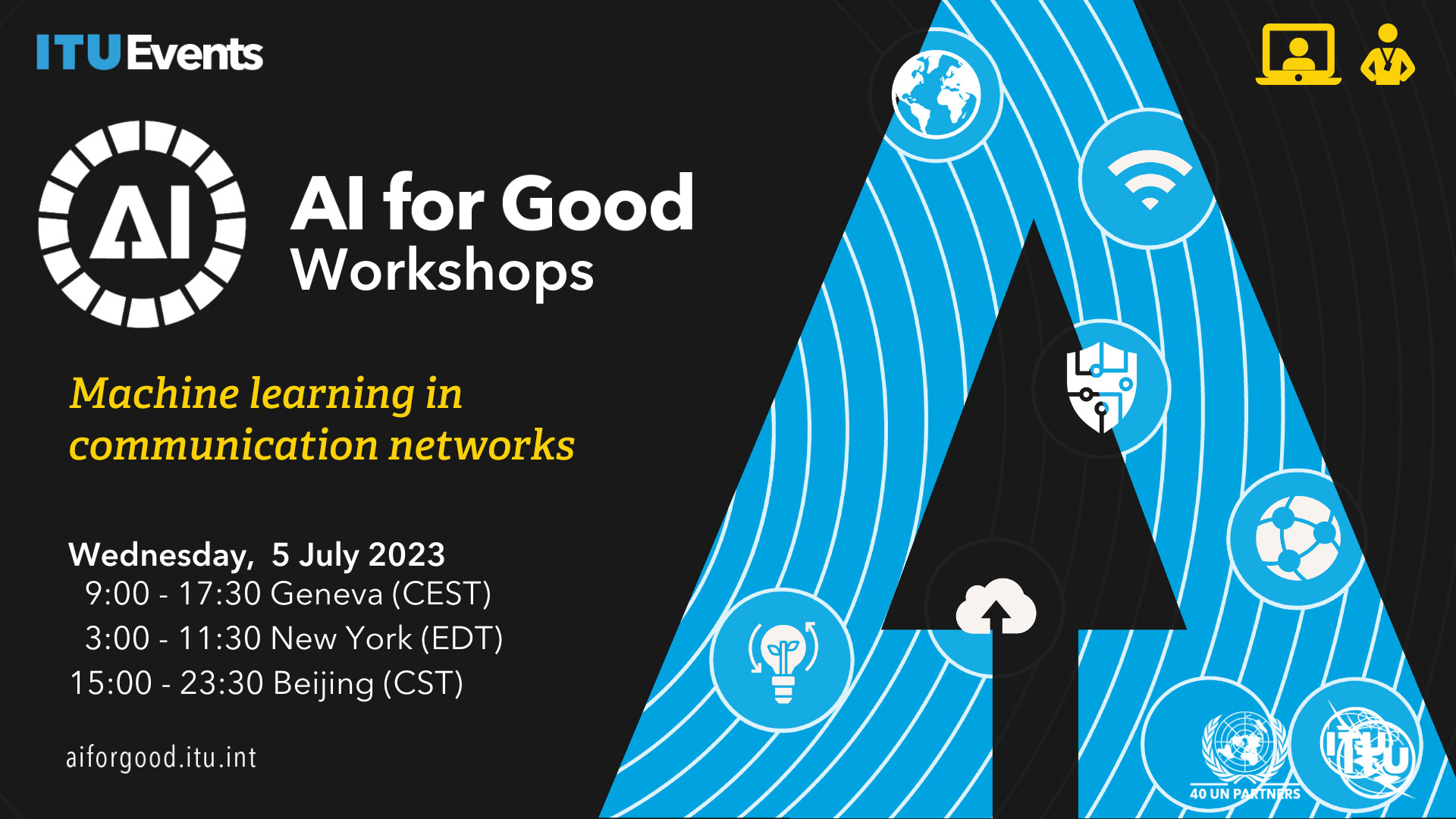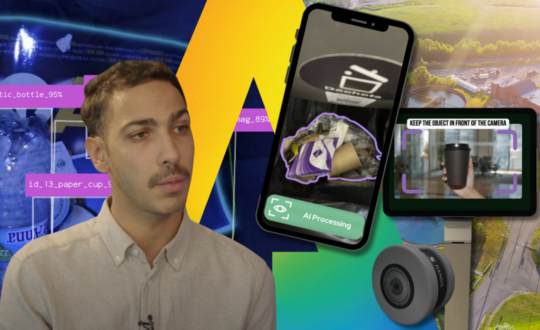Machine learning in communication networks

* Register (or log in) to the AI4G Neural Network to add this session to your agenda or watch the replay

* Register (or log in) to the AI4G Neural Network to add this session to your agenda or watch the replay
The “Machine learning in communication networks” workshop delves into the rapidly evolving landscape of AI-driven networks, as we journey from 5G to 6G and beyond. It brings together experts from across the industry to discuss the challenges and opportunities that arise from the integration of machine learning and artificial intelligence in network design and operations.
Through four captivating sessions, attendees will explore the impact of generative AI on network use cases, the future of AI-native open networks, the dilemma faced by operators in choosing the right platforms for 6G, and the integration of AI/ML in 6G and future networks. Experts will discuss the role of standards organizations in this technological transformation, addressing the challenges of data privacy, architecture evolution, and the balance between cloud and edge computing.
Join us for an engaging and insightful conference, as we examine the transformative potential of AI and machine learning in shaping the next generation of networks, and work together to build a more connected, intelligent, and innovative future.
This session starts with an imaginary (?) scenario where generative AI has taken over the networks. Use cases are generated by fine-tuned models, architectures and code, including test code generated by co-pilots and ChatGPT(-likes); digital twins including scenarios and objects are generated by AI-enabled gaming engines; and MLOps pipelines are triggered autonomously. Experts will present their views on the topic, including important challenges such as data collection and modeling in networks, AI-empowered features in 6G and the current state of MLOps. Discussions will focus on questions such as whether networks ready are for this, and identify some of the major areas which need further study including current standards and gaps.
Questions to answer:
1. Given the recent advances in AI/ML, are networks ready for taking advantage of these?
2. How to bring the best advances to networks so that operators and end-users can benefit? what are the integration strategies?
Expected conclusions:
1. More study is needed in the areas of ........
2. Practical challenges in ......
3. Standards gaps in this area are ....
In recent years, we have witnessed several advances in network architectures. Networks are becoming more open and decentralized. On one hand, data is increasingly generated, augmented and processed at the edge of the network. On the other hand, cloud based, scalable compute can enable AI/ML models to infer at high speeds. Sandbox environments would allow for training machine learning models on edge data while keeping it private and secure while controllers and digital twins are spun up on demand. Many algorithms and AI capabilities are now offered as cloud-based services that can be integrated on demand.
Juxtaposing AI-enabled feature advances in future networks such as beam selection, semantic awareness, RIS-enabled radio optimizations, with the architecture evolution, the standards organizations face the difficult task of choosing the right network architectures, placement of functionalities and level of exposure of data while providing application development capabilities to boost opportunities for innovation.
These considerations present new challenges for future networks such as 6G. To benefit from open networks, edge data, and on-demand models, standards organizations need to carefully consider what are the collaborative working models, especially for proof of concepts which can answer some of these questions. Discussions in this session would focus on some of the important considerations in AI-native design and network architectures which can host those designs.
Questions to answer:
1. what are the evolutions in network architectures needed for enabling the integration of AI/ML?
2. What are the techniques to enable generation, collection, utilization of data in networks beyond 5G?
Expected conclusions:
1. Collaborative analysis is needed in the areas of ........with ......
2. PoC studies can mitigate risks in ....
3. The relevant open source studies are .....
4. use cases such as ... has data from ... part of the network, which may be extracted via ... interface, models may be trained in ... and deployed in ...
The 6G vision is shaping up with emerging use cases from metaverse and other user-centric apps. Standards Developing Organizations are marching on with requirements and feature analysis for future networks. This spurs the need for network controllers and agents to manage bandwidth and latency demands from billions of devices. Network platforms spanning software, hardware, cloud and edge with/without GPUs, TPUs, FPGAs and sensors are emerging. Network operators now face a dilemma: what are the right platforms for 6G? Where does enterprise networks come into the picture? Do the major value-adding algorithms, including the network service optimization, become AI-ed and autonomous and move to cloud? The key questions to ponder over are: What platform architectures do we need for this network evolution? What role does open source play in these architectures?
Questions to answer:
1. what are the platform architectures needed for this?
2. whats the role of open source in such architectures?
AI/ML is becoming more and more pervasive in 5G and future networks but the realization options for AI/ML integrated use cases appear fragmented from a method, platforms and design view point. This is partly due to heterogeneity in use case requirements, datasets and models. In addition, we face challenges in bringing innovations from lab to networks due to different perspectives between innovators vs. incumbents, open vs. black boxes, models vs. people (developers, service providers, maintainers, operational engineers), architecture evolution vs. leap-frogging across generations, and cloud vs. edge. This brings to focus the unenviable position of Standards Developing Organizations such as ITU which is required to come up with roadmaps, work items for integration of AI/ML in future networks including 6G.
Questions to answer:
1. what should ITU and other SDOs do?
2. Are there pre-standard, activities to look at?
3. Is the Challenge activities serving the audiences well? what can be done better there?
Expected conclusions:
1. In collaboration with other SDOs, ITU should study ....
2. Challenge should focus on ...type of use cases, expand to ....type of data and models.
3. Papers and code should be published ....more/less... frequently


























For important information regarding the classification, please go to the Division’s website and review the last two questions in the Q&A page. Please be advised that the utilization of this list by AI for Good is exclusively for the purpose of ticketing for the 2024 AI for Good Global Summit, unless otherwise specified
| Country or Area | ISO-alpha2 Code | ISO-alpha3 Code | Developed / Developing regions |
| Algeria | DZ | DZA | Developing |
| Egypt | EG | EGY | Developing |
| Libya | LY | LBY | Developing |
| Morocco | MA | MAR | Developing |
| Sudan | SD | SDN | Developing |
| Tunisia | TN | TUN | Developing |
| Western Sahara | EH | ESH | Developing |
| British Indian Ocean Territory | IO | IOT | Developing |
| Burundi | BI | BDI | Developing |
| Comoros | KM | COM | Developing |
| Djibouti | DJ | DJI | Developing |
| Eritrea | ER | ERI | Developing |
| Ethiopia | ET | ETH | Developing |
| French Southern Territories | TF | ATF | Developing |
| Kenya | KE | KEN | Developing |
| Madagascar | MG | MDG | Developing |
| Malawi | MW | MWI | Developing |
| Mauritius | MU | MUS | Developing |
| Mayotte | YT | MYT | Developing |
| Mozambique | MZ | MOZ | Developing |
| Réunion | RE | REU | Developing |
| Rwanda | RW | RWA | Developing |
| Seychelles | SC | SYC | Developing |
| Somalia | SO | SOM | Developing |
| South Sudan | SS | SSD | Developing |
| Uganda | UG | UGA | Developing |
| United Republic of Tanzania | TZ | TZA | Developing |
| Zambia | ZM | ZMB | Developing |
| Zimbabwe | ZW | ZWE | Developing |
| Angola | AO | AGO | Developing |
| Cameroon | CM | CMR | Developing |
| Central African Republic | CF | CAF | Developing |
| Chad | TD | TCD | Developing |
| Congo | CG | COG | Developing |
| Democratic Republic of the Congo | CD | COD | Developing |
| Equatorial Guinea | GQ | GNQ | Developing |
| Gabon | GA | GAB | Developing |
| Sao Tome and Principe | ST | STP | Developing |
| Botswana | BW | BWA | Developing |
| Eswatini | SZ | SWZ | Developing |
| Lesotho | LS | LSO | Developing |
| Namibia | NA | NAM | Developing |
| South Africa | ZA | ZAF | Developing |
| Benin | BJ | BEN | Developing |
| Burkina Faso | BF | BFA | Developing |
| Cabo Verde | CV | CPV | Developing |
| Côte d’Ivoire | CI | CIV | Developing |
| Gambia | GM | GMB | Developing |
| Ghana | GH | GHA | Developing |
| Guinea | GN | GIN | Developing |
| Guinea-Bissau | GW | GNB | Developing |
| Liberia | LR | LBR | Developing |
| Mali | ML | MLI | Developing |
| Mauritania | MR | MRT | Developing |
| Niger | NE | NER | Developing |
| Nigeria | NG | NGA | Developing |
| Saint Helena | SH | SHN | Developing |
| Senegal | SN | SEN | Developing |
| Sierra Leone | SL | SLE | Developing |
| Togo | TG | TGO | Developing |
| Anguilla | AI | AIA | Developing |
| Antigua and Barbuda | AG | ATG | Developing |
| Aruba | AW | ABW | Developing |
| Bahamas | BS | BHS | Developing |
| Barbados | BB | BRB | Developing |
| Bonaire, Sint Eustatius and Saba | BQ | BES | Developing |
| British Virgin Islands | VG | VGB | Developing |
| Cayman Islands | KY | CYM | Developing |
| Cuba | CU | CUB | Developing |
| Curaçao | CW | CUW | Developing |
| Dominica | DM | DMA | Developing |
| Dominican Republic | DO | DOM | Developing |
| Grenada | GD | GRD | Developing |
| Guadeloupe | GP | GLP | Developing |
| Haiti | HT | HTI | Developing |
| Jamaica | JM | JAM | Developing |
| Martinique | MQ | MTQ | Developing |
| Montserrat | MS | MSR | Developing |
| Puerto Rico | PR | PRI | Developing |
| Saint Barthélemy | BL | BLM | Developing |
| Saint Kitts and Nevis | KN | KNA | Developing |
| Saint Lucia | LC | LCA | Developing |
| Saint Martin (French Part) | MF | MAF | Developing |
| Saint Vincent and the Grenadines | VC | VCT | Developing |
| Sint Maarten (Dutch part) | SX | SXM | Developing |
| Trinidad and Tobago | TT | TTO | Developing |
| Turks and Caicos Islands | TC | TCA | Developing |
| United States Virgin Islands | VI | VIR | Developing |
| Belize | BZ | BLZ | Developing |
| Costa Rica | CR | CRI | Developing |
| El Salvador | SV | SLV | Developing |
| Guatemala | GT | GTM | Developing |
| Honduras | HN | HND | Developing |
| Mexico | MX | MEX | Developing |
| Nicaragua | NI | NIC | Developing |
| Panama | PA | PAN | Developing |
| Argentina | AR | ARG | Developing |
| Bolivia (Plurinational State of) | BO | BOL | Developing |
| Bouvet Island | BV | BVT | Developing |
| Brazil | BR | BRA | Developing |
| Chile | CL | CHL | Developing |
| Colombia | CO | COL | Developing |
| Ecuador | EC | ECU | Developing |
| Falkland Islands (Malvinas) | FK | FLK | Developing |
| French Guiana | GF | GUF | Developing |
| Guyana | GY | GUY | Developing |
| Paraguay | PY | PRY | Developing |
| Peru | PE | PER | Developing |
| South Georgia and the South Sandwich Islands | GS | SGS | Developing |
| Suriname | SR | SUR | Developing |
| Uruguay | UY | URY | Developing |
| Venezuela (Bolivarian Republic of) | VE | VEN | Developing |
| Kazakhstan | KZ | KAZ | Developing |
| Kyrgyzstan | KG | KGZ | Developing |
| Tajikistan | TJ | TJK | Developing |
| Turkmenistan | TM | TKM | Developing |
| Uzbekistan | UZ | UZB | Developing |
| China | CN | CHN | Developing |
| China, Hong Kong Special Administrative Region | HK | HKG | Developing |
| China, Macao Special Administrative Region | MO | MAC | Developing |
| Democratic People’s Republic of Korea | KP | PRK | Developing |
| Mongolia | MN | MNG | Developing |
| Brunei Darussalam | BN | BRN | Developing |
| Cambodia | KH | KHM | Developing |
| Indonesia | ID | IDN | Developing |
| Lao People’s Democratic Republic | LA | LAO | Developing |
| Malaysia | MY | MYS | Developing |
| Myanmar | MM | MMR | Developing |
| Philippines | PH | PHL | Developing |
| Singapore | SG | SGP | Developing |
| Thailand | TH | THA | Developing |
| Timor-Leste | TL | TLS | Developing |
| Viet Nam | VN | VNM | Developing |
| Afghanistan | AF | AFG | Developing |
| Bangladesh | BD | BGD | Developing |
| Bhutan | BT | BTN | Developing |
| India | IN | IND | Developing |
| Iran (Islamic Republic of) | IR | IRN | Developing |
| Maldives | MV | MDV | Developing |
| Nepal | NP | NPL | Developing |
| Pakistan | PK | PAK | Developing |
| Sri Lanka | LK | LKA | Developing |
| Armenia | AM | ARM | Developing |
| Azerbaijan | AZ | AZE | Developing |
| Bahrain | BH | BHR | Developing |
| Georgia | GE | GEO | Developing |
| Iraq | IQ | IRQ | Developing |
| Jordan | JO | JOR | Developing |
| Kuwait | KW | KWT | Developing |
| Lebanon | LB | LBN | Developing |
| Oman | OM | OMN | Developing |
| Qatar | QA | QAT | Developing |
| Saudi Arabia | SA | SAU | Developing |
| State of Palestine | PS | PSE | Developing |
| Syrian Arab Republic | SY | SYR | Developing |
| Turkey | TR | TUR | Developing |
| United Arab Emirates | AE | ARE | Developing |
| Yemen | YE | YEM | Developing |
| Fiji | FJ | FJI | Developing |
| New Caledonia | NC | NCL | Developing |
| Papua New Guinea | PG | PNG | Developing |
| Solomon Islands | SB | SLB | Developing |
| Vanuatu | VU | VUT | Developing |
| Guam | GU | GUM | Developing |
| Kiribati | KI | KIR | Developing |
| Marshall Islands | MH | MHL | Developing |
| Micronesia (Federated States of) | FM | FSM | Developing |
| Nauru | NR | NRU | Developing |
| Northern Mariana Islands | MP | MNP | Developing |
| Palau | PW | PLW | Developing |
| United States Minor Outlying Islands | UM | UMI | Developing |
| American Samoa | AS | ASM | Developing |
| Cook Islands | CK | COK | Developing |
| French Polynesia | PF | PYF | Developing |
| Niue | NU | NIU | Developing |
| Pitcairn | PN | PCN | Developing |
| Samoa | WS | WSM | Developing |
| Tokelau | TK | TKL | Developing |
| Tonga | TO | TON | Developing |
| Tuvalu | TV | TUV | Developing |
| Wallis and Futuna Islands | WF | WLF | Developing |
New membership are not allowed.
Are you sure you want to remove this speaker?
